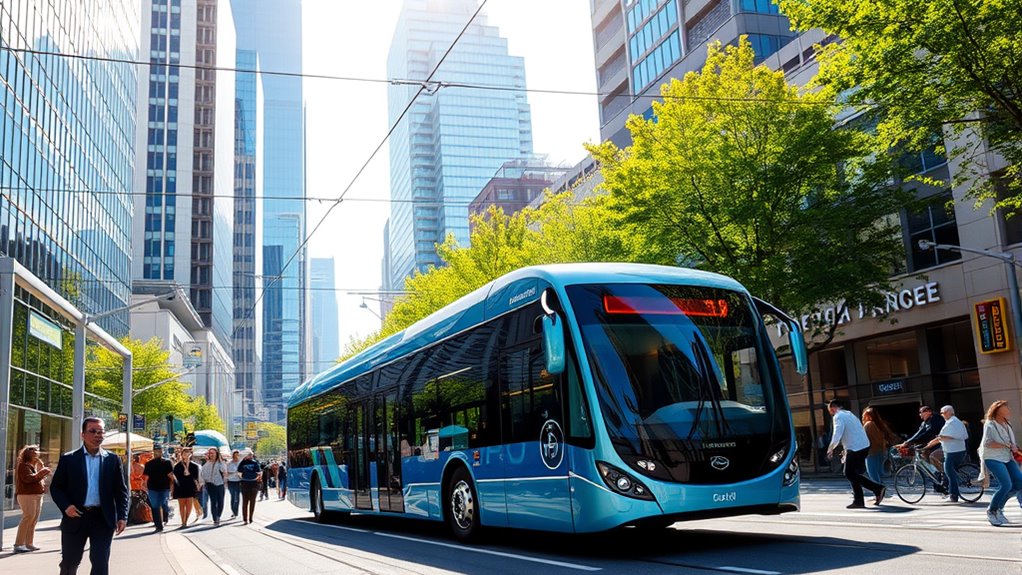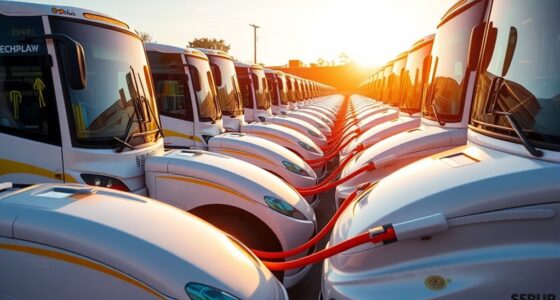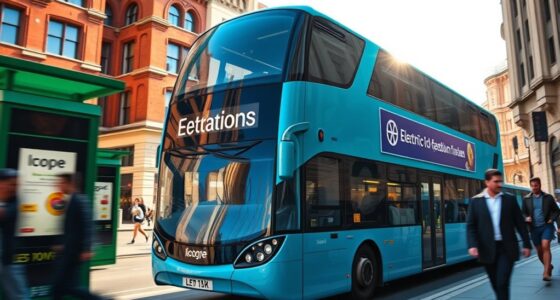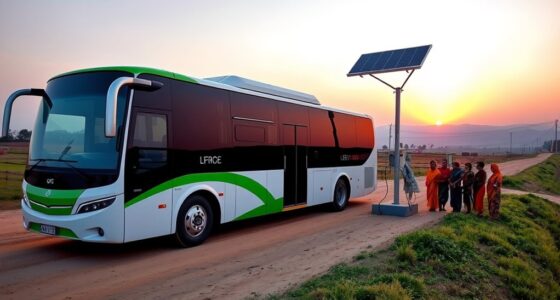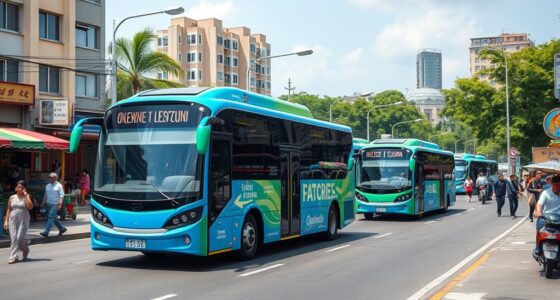Electric buses have proven highly successful in high-density urban areas by reducing emissions, decreasing noise, and lowering operational costs. They provide cleaner, quieter transit options that improve air quality and meet strict city regulations for zero-emission vehicles. With robust infrastructure, fast charging, and strong policy support, electric buses keep fleets efficient and reliable. If you want to understand how these factors come together to boost electric bus adoption, there’s more to explore.
Key Takeaways
- Electric buses reduce noise pollution and improve urban livability in high-density areas.
- Reliable fast charging infrastructure minimizes operational downtime and maximizes bus uptime.
- Strong policy support and incentives accelerate electric bus adoption in dense urban environments.
- Lower operational costs and environmental benefits make electric buses economically viable for high-demand routes.
- Technological innovations like opportunity charging and battery swapping enhance efficiency in crowded cities.
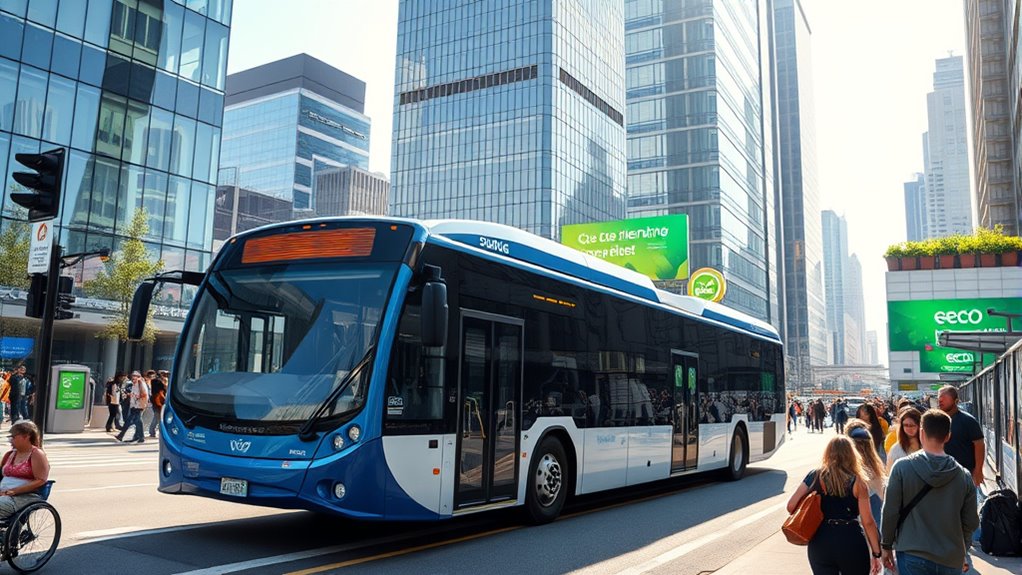
Electric buses are transforming urban transportation by offering a cleaner, quieter, and more cost-effective alternative to traditional diesel fleets. As cities endeavor to reduce pollution and meet climate goals, the adoption of electric buses accelerates worldwide. The global electric bus market is expected to reach $65 billion by 2034, growing at a compound annual growth rate of over 15%.
Electric buses are revolutionizing urban transit with cleaner, quieter, and cost-effective solutions worldwide.
In Europe, sales of battery electric city buses reached 43% in 2023, with countries like Italy registering 27.5% of new urban bus registrations as electric. By 2030, Europe aims for 75% of urban bus sales to be electric, reflecting strong regional momentum.
Meanwhile, China leads the global deployment, supported by government subsidies that initially focused on vehicle purchases but shifted toward developing robust charging infrastructure, which is critical for high-density urban areas. India’s FAME II and PM e-Bus Sewa schemes have helped expand electric bus fleets across hundreds of cities, addressing earlier charging gaps.
Globally, approximately 50,000 electric buses were sold in 2023, with over 635,000 now operational worldwide, demonstrating widespread adoption.
Despite these positive trends, charging infrastructure remains a key challenge. Inadequate planning can lead to the need for two electric buses per diesel route, doubling costs and complicating operations. Grid capacity and energy management are critical, especially in densely populated areas where high bus frequency demands reliable, fast charging solutions.
Poor charging infrastructure can result in operational downtime, reducing fleet efficiency and increasing costs. China has responded by prioritizing infrastructure alongside subsidies, while India’s schemes have focused on scaling operations effectively. Proper planning and investments in charging stations—such as opportunity charging during routes or overnight depot charging—are essential for maximizing uptime and operational efficiency.
Policy and regulations continue to drive electric bus adoption. The EU has proposed a target for 75% of bus sales to be electric by 2030, pushing cities to accelerate their decarbonization efforts. Zero-emission mandates in cities like London and Amsterdam further incentivize regional shifts.
Local incentives, including grants and tax breaks, help offset the higher upfront costs of electric buses, making them more accessible for operators. These policies align with environmental benefits, such as reducing particulate matter and nitrogen oxides, which improve air quality.
Lower operational costs for fuel and maintenance, along with long-term savings, further strengthen the case for electric buses. Additionally, quieter operation enhances urban livability, making cities more liveable and less noisy.
Regional adoption patterns show China’s leadership in deploying electric buses, supported by extensive subsidies and infrastructure development. Europe’s city bus segments are experiencing rapid growth, outpacing other transport modes like coach electrification.
India’s focus on operational scalability has led to a surge in electric bus fleets, especially after the success of its schemes. Emerging markets in Latin America and Southeast Asia are also beginning to adopt mid-sized electric buses.
Although U.S. cities are prioritizing electric buses in climate action plans, their adoption remains behind Asia and Europe. As technology advances, innovations such as battery swapping and autonomous electric buses promise to further enhance efficiency.
With continued policy support and infrastructure investment, electric buses are poised to become the backbone of sustainable urban transit. Recognizing the importance of charging infrastructure, many cities are investing heavily to ensure reliable service and maximize the environmental benefits of electric mobility.
Frequently Asked Questions
How Do Electric Buses Impact Local Air Quality Long-Term?
You see, electric buses substantially improve long-term local air quality by cutting emissions of pollutants like particulate matter, NOx, VOCs, and CO.
As you adopt more electric buses, these reductions lead to cleaner air and healthier communities.
Over time, this shift helps cities meet environmental targets, reduces respiratory health issues, and creates a more sustainable urban environment.
Your efforts contribute to a lasting positive impact on air quality.
What Are the Main Challenges in Implementing Electric Bus Infrastructure?
Imagine you’re stepping into the future, but infrastructure hurdles remain. You face charging infrastructure gaps, site power limits, and high installation costs.
Grid capacity strains during peak times, and upgrading systems takes time.
Operational challenges include route planning and battery range issues, while financial hurdles involve upfront costs and uncertain maintenance.
To succeed, you need strategic planning, investment, and policies aligned to overcome these barriers effectively.
How Do Electric Buses Compare in Total Cost of Ownership?
You’ll find electric buses often have a lower total cost of ownership compared to diesel buses. They save you money on fuel and maintenance, which can reduce expenses by up to 30-40%.
Although initial infrastructure costs exist, government incentives and decreasing battery prices help offset them.
Over time, the lower operational costs and improved technology make electric buses more economical, especially with careful planning and investment.
What Innovations Are Emerging to Improve Battery Life?
You’re curious about innovations that extend battery life. Researchers develop models to predict degradation, while real-time capacity estimation improves efficiency.
Advances like high-energy CATL Tectrans batteries, solid-state tech, and improved thermal management boost longevity.
Smart charging protocols and autonomous diagnostics during nighttime help monitor and prolong battery health.
These innovations ensure your electric buses run longer, reducing replacement costs and enhancing overall operational reliability.
How Do Passenger Perceptions Influence Electric Bus Adoption?
Did you know 85% of passengers prefer electric buses because of their quiet, smooth ride?
Your perceptions play a big role in adoption—seeing electric buses as environmentally friendly, offering better comfort, and reducing noise influences your choice.
When you value their cleaner air, silent operation, and modern image, you’re more likely to support and choose electric buses, helping cities shift to greener, more efficient urban transport.
Conclusion
Just as a lighthouse guides ships safely through stormy waters, electric buses illuminate a cleaner, quieter future for city living. Their success in high-density areas shows your city can transform challenges into opportunities, steering toward sustainable mobility. By embracing this shift, you’re paving the way for healthier neighborhoods and brighter tomorrows. Remember, every electric bus on the road is a beacon, leading your community toward innovation and environmental stewardship.
